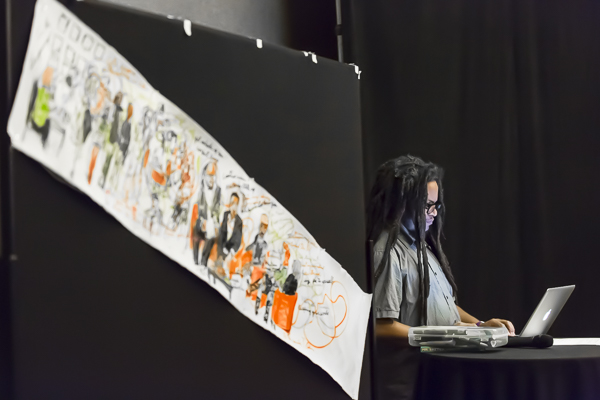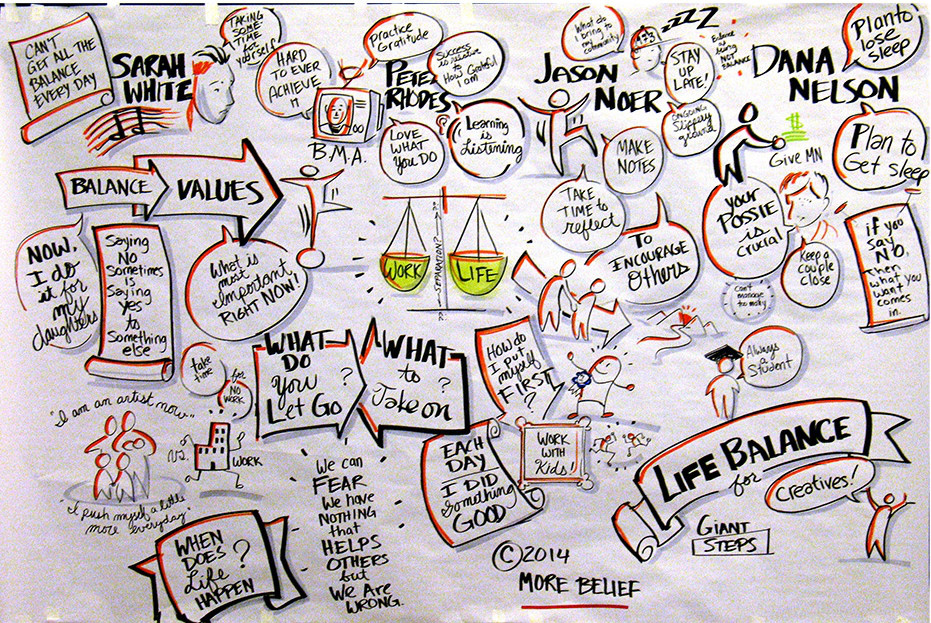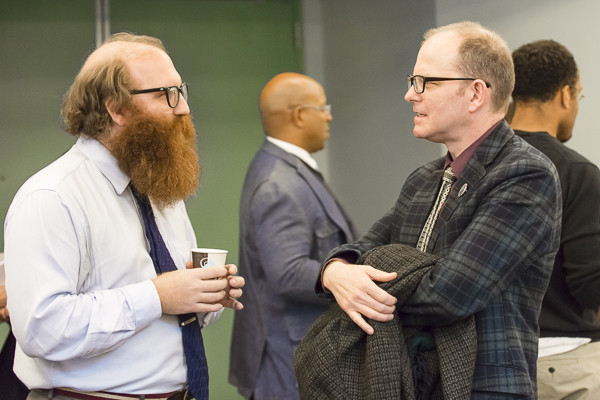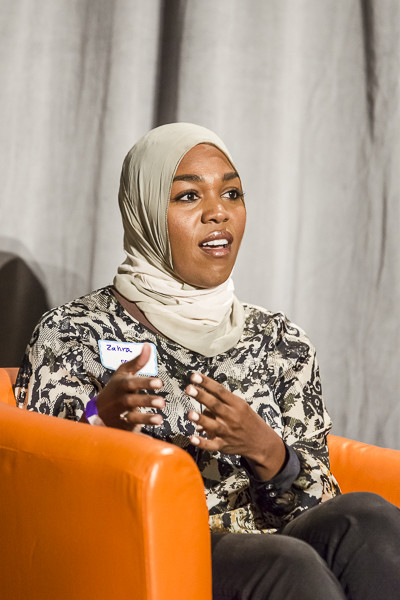We Are All Entrepreneurs Now
Sheila Regan reports back from the recent Giant Steps conference in Minneapolis, on the winding paths and professional thickets of today's "creative entrepreneurs."

When I think of business, I think of suits. In college, business majors were the jocks and Republicans, and I wanted to be as far away from anything like that as I could. I wasn’t much interested in science or computers, so I ended up majoring in theater, simply because working on the stage was the thing I actually liked doing. But today, as I try to make my living in the arts, I’m wondering if maybe I should have taken a business class or two after all.
In October I attended the Giant Steps conference, an annual event founded by Susan Campion and M.anifest, aimed at “entrepreneurial creatives and creative entrepreneurs” and held at the Minneapolis Convention Center. The conference drew several hundred people — mostly artist, musician and designer types, but also people who run their own business in the arts and entertainment communities and other outfits for which creativity and design is integral to their brand.
I’ll be honest: I came to this gathering with plenty of skepticism. I make my way as a freelancer in various capacities, from writing to teaching to performing in plays; sometimes I “act” as a mental health patient for Crisis Intervention Training. I suppose you could describe this grab-bag approach to self-employment as entrepreneurial, but it doesn’t much feel like that. I don’t think of it as running my own business (although that’s how I fill out my taxes). “Entrepreneurial,” to me, calls to mind business plans and financial objectives. And, by my reckoning, what I’m doing is hustling to scrape together a (very modest) living made up of lots of highly underpaid gigs.

Giant Steps defines “creative entrepreneur” pretty loosely. In fact, speaking to that very definition were a number of small business owners, nonprofit leaders, individual artists, musicians, choreographers, consultants, activists and others who, like me, nimbly go back and forth between different roles depending on the project and the day.
Early on, I stopped to chat with John Heimbuch, co-Artistic Director of Walking Shadow and a guy who, in addition to running his company, has parallel careers as a playwright, filmmaker, and musician. While those various roles are tied together, “they live in slightly different places,” he says. As an artistic director, he’s looking to build his company’s reputation, reach out to new audiences and support artists. As an individual artist who happens to work with Walking Shadow, he’s says, “I’m also using that leverage, in terms of creating visibility for my own work. But I recognize [those aims] are sometimes at cross-purposes.”
In this very nonprofit-oriented, philanthropically rich state, Heimbuch says, large foundations like Bush and McKnight drive much of the innovation here. “The goal of artists or creative people is to learn how to utilize those support structures that we do have in order to open doors,” he said. Heimbuch sees his path as moving through the current structure, achieving goals within the system as it’s set up.
However, not everyone I talked to felt totally comfortable with that strategy. For Charles Campbell, co-Artistic Director of Skewed Visions, while artists can learn things from business people, “if you try to run your art like a business, you’ll fail.” He says, “There’s so many things that could go wrong.” As an artist, you want your voice to have reach, and you also want to be able to make a living. But working under a capitalist model, where you are in the business of selling your “product,” is tough if you don’t happen to make work with mass appeal. Campbell sees cynicism, sarcasm and satire as vitally important, at least in his own aesthetic as an artist. For him, the positivity that comes with embracing entrepreneurialism too often comes at the expense of critical thinking. “We need people who are outsiders to let us know what we’re doing” in an honest way, he says.


When I spoke with writer and editor Julia Opoti, she echoed Campbell’s ambivalence. Opoti says she is unsure about how she fits into the model of the “creative entrepreneur” — though, from the outside, that’s exactly what she appears to be, as she carves out her own career path creating content in various capacities. But Opoti, like me, feels resistance to being “part of the system,” she says. We know we need to eat and pay rent, but we resist working within the existing structures of grant funding and “business” because we don’t think that system is really working well, for artistic work or for people who make it. There is a disconnect here. Consider the many creative people who work in the arena of social justice, with the express aim of breaking down walls of the status quo. “How can we challenge ourselves to do better?” Opoti asks.
The question of how artists and “creative entrepreneurs” define success framed much of the discussion at the conference. In her opening remarks, Susan Campion, co-host and co-founder of Giant Steps, acknowledged that each person in the room likely had very different goals and different ways of achieving them. “We are not here to give you the blueprint for success,” she said. Rather, the day’s panels were aimed at finding ways for everyone to discover their own route to sustainable, creative work and careers.
Jobie Bakama, who works in the film and music industry, says success, for him, simply means having the freedom to do what he loves. “I do exactly what I want to do every day. We get paid well to do it, and to me that’s successful.” But, while business success and career satisfaction were clearly on a lot of minds, it’s too glib to measure personal achievement, as defined by this crowd, in primarily monetary terms. For some, especially those working in the social justice arena, successful work involves making an impact on society. Choreographer Ananya Chatterjea brought up an anecdote about a human rights lawyer in Pakistan who had people protesting outside of her office, an indication that she had obviously hit a nerve. Chatterjea says that urge to provoke is something she can relate to, as her own work often deals in contentious issues, like environmental justice. “ It really resonates with me,” Chatterjea says. “Oh really? Did it make you so mad? That’s good.”
At the conference, Nancy Lyons talked about her new media company, Clockwork Active Media. The company aims to treat people well and works to be a “values-driven organization,” she said. Lyons says she’s glad to “do stuff that makes me feel good,” like fostering a healthy work culture that includes a balance of family and career. Her efforts haven’t gone unnoticed: just this year, Lyons was invited to the White House as an exemplary business leader, and she was asked to join Minnesota Public Radio’s Board of Trustees.

But what struck me most about the gathering at Giant Steps wasn’t the talk of policy or “success” – it was the sheer amount of talent and enthusiasm, brought together in one place. The boldness of the work represented, the perseverance both well-established and up-and-coming artists show in pushing forward on such tricky career paths as these. One of my favorite takeaways was from Zahra Aljabri, proprietor of an online boutique called Mode-sty that caters to women who want to dress conservatively but fashionably. Aljabri says, as she considered this venture, she just asked herself the question: “Why not me?” And she’s convinced that she does, in fact, have a unique vision worth sharing. Still, she says she has found one of her biggest struggles is learning to hold fast to that strong inner voice, even in the face of criticism and inevitable setbacks. I suspect that’s the real challenge for artists and “creative entrepreneurs:” success has less to do with money or recognition than it does having enough belief in yourself to keep you pushing forward with the long view in mind, regardless of the obstacles and receptive to but not hobbled by criticism of your efforts.
To my mind, hip hop poet and rapper, Desdamona, pretty much sums up the ideal mindset, saying, “I love to make music, and I love to share it with people. But I don’t sit around thinking about ways to make it big. I care about my family and friends and my community. For me, that’s the reason I do what I do.”